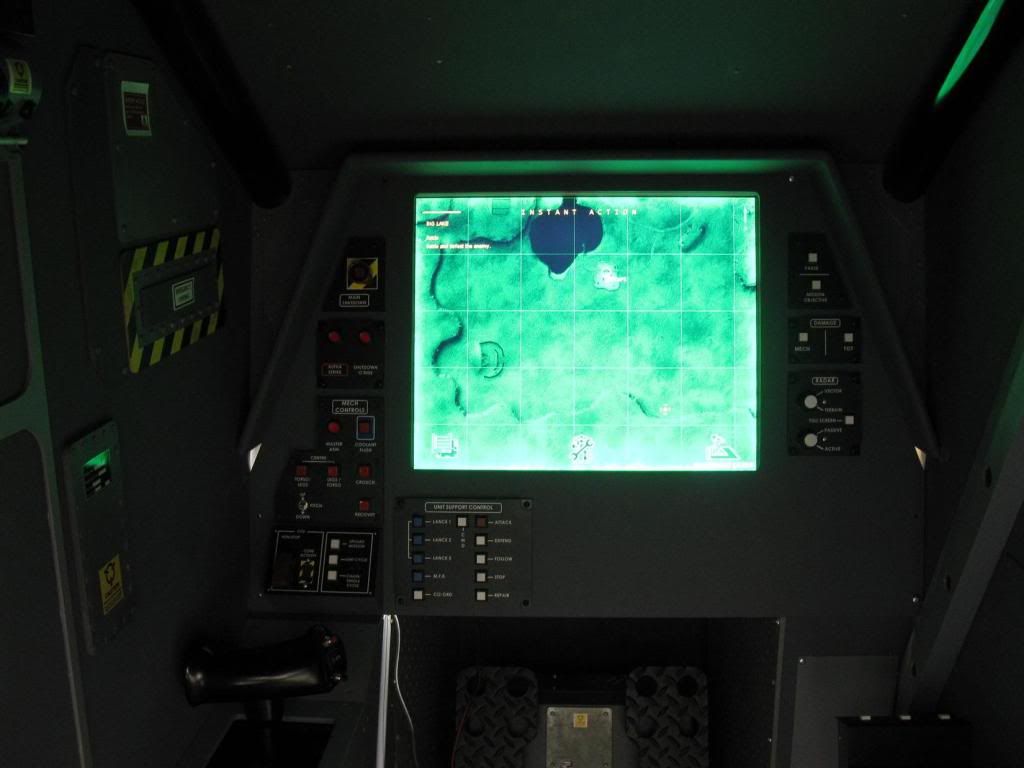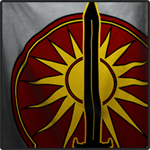http://simhq.com/for...or_Cockpit.html

It's about 4.5-5 feet tall or so...

The seat, obviously. He built it from scratch...

Inside the cockpit ... he made his own throttles and sticks and pretty much everything; apparently it's all functional.
There's a LOT more pictures and information at the thread.
This guy's build is circa 2009-10, apparently, anyways, head over and have a look.
I'm thinking try to see if the FRex simcon motion seat would work in a 'pit build (it can simulate up to 5 g-forces or so) could be rigged up to "talk" to some stepper motors which the actual simpit itself would be mounted into ... simulate g-forces and the walking motion of a BattleMech; put in a set of hard-core heater units to simulate cockpit heat; build a cooling vest setup. Use 3 or so video displays for "viewscreens," ... you wouldn't even need a track-ir setup, if the MWO guys give us outputs for just the raw video to be split onto the viewscreens and raw data outputs for the readouts and inputs for the control stuff...



http://www.sarna.net...nology#Controls
Quote
The left weapons status display for half of the mech's weapons (and any associated ammunition) with toggles for locking the various weapons into any of the target interlock circuits. This display also shows the recharge or reload status of the weapons it tracks.
The primary screen mode toggles, which controls what is viewed on the primary cockpit screen (the HUD). There is a toggle for active/passive sensor mode, a toggle to active iff transponder tracking, and toggles for the various sensor tracking modes, and a toggle for a searchlight (if the 'Mech is so equipped).
Speaker and microphone controls - this controls the pilot's microphone and the 'Mechs external microphones, along with the 'Mechs internal and external speaker systems.
In the center: Between the MechWarriors legs on the floor (or hanging from the top of the command chair on some 'Mechs) are the emergency ejection handles, which activate explosive bolts that blow out cockpit panels and disconnects the neurohelmet before ejecting the pilot from 'Mech.
The computer message relay which relays status information from the 'Mechs DI computer on the 'Mechs condition.
The main control switches - reverse movement mode, torso rotation mode, target interlock configuration switch, sensor configuration switch, and the overheat lockout over-ride.
The primary view screen (the HUD). The targeting reticule, tracking display, and other information readouts are displayed here. Alternative sensor modes, indicators, and tags are also possible on this screen. This is also the polarized cockpit central view screen, which, along with the other view screens, is darkened in response to blinding flashes of light.
The 'Mechs heat readout, below the primary view screen.
The secondary view screen and its controls, below the heat readout indicator and HUD. This screen usually monitors the 'Mechs armor and systems status, sensor readouts, target 'Mech status, and other functions.
The battle computer keypad and information storage input slot, below the secondary view screen. This keypad interfaces with the DI computer. Information readout for this is on the secondary view screen. This keypad is used to normally used to control the 'Mechs security systems and to transfer control of functions between the various 'Mech computer systems.
The Anti-missile warning system, on 'Mechs equipped with AMS. It lights to indicate incoming missiles, has an AMS ammunition readout and a toggle for activating/deactivating the system.
Physical combat and interaction mode switches - these activate the physical combat modes which switche the foot pedals and joysticks to control kicking, punching, and carrying, and other similar functions. Waldo gloves, located on either side of the command couch, are used on older 'Mechs for more intricate arm and hand controls; while newer 'Mechs have more capable computers, programming, and sensor controls that allow for some more complex movements such as grasping an improvised club, carefully carrying an unconscious pilot, or engaging in large scale battlefield engineering, all without much pilot input.
Gyroscope start up and calibration controls, for starting up the gyroscope and controlling the level of balance input to the 'Mech from the neurohelmet.
The foot pedals, on the floor at the front, which control turning, kick mode, and jump jets. To turn you depress the pedal on the side you wish to turn to (push down on the left pedal to turn left). The pedals can be unlocked and can tilt, swivel, or otherwise pivot in order to control other movement modes, such as side stepping and more complex functions. Depressing both pedals quickly all the way to the floor activates the 'Mechs jump jets. Once activated, left and right feathering of the jump jets is achieved by depressing either the left or right foot pedal. It is also possible to indicate a landing target with the main or secondary joystick via point and click while in jump mode. The 'Mech will attempt to land at the target area indicated. The jump jets are deactivated by quickly depressing both foot pedals to the floor again.
DI computer access and control panel - this allows the MechWarrior to activate or deactivate the DI computer.
Security circuit control - down near the foot pedals, it contains the hardware with the 'Mechs security access codes.
On the right: The main joystick. This is the primary control for targeting the weapons systems and control of the 'Mechs arms. It has firing triggers for each of the target interlock circuits (TIC), with as many as six triggers. Weapons aiming is achieved by using this stick to "point" with the reticule on the primary view screen and "clicking" with the desired weapons triggers.
The finger rests are sensitive and are used to help control the 'Mechs hands in physical modes. When in physical mode the joystick moves up and down as well as side to side.
The right weapons status display for half of the mech's weapons (and any associated ammunition) with toggles for locking the various weapons into any of the target interlock circuits. This display also shows the recharge or reload status of the weapons it tracks.
Emergency ammo dumping control - used on conjunction with the left and right weapons status displays to eject unused ammo.
Communications controls - used to interact with and control communications networks which the 'Mech is capable of interacting with, be they conventional RF (radio frequency), satellite, microwave, laser link, or land line hookup and the various secure communications modes these methods employ.
Some neurohelmets include sensors that facilitate channel switching. ECM, Tag, C3/C3i, standard jamming modes, communications interception and decryption, and Artemis IV/V fire control systems are associated with the communications controls.
Life support controls - these control the cockpit environmental systems and give a readout of the cockpit temperature and life support systems status.
Coolant lines hookup and control - the MechWarriors coolant vest is attached to and controlled from this panel.
The emergency cockpit blast away system - activates the explosive bolts on the cockpit view ports but does not activate the ejection system.
Ignition switch - a large red bar which is used to bring the fusion reactor up to minimal operational levels which powers the gyro and cockpit systems for BattleMech startup. It locks into place upon startup.
With some control and readout outputs from mwo ...
Oh, the possibilites if we can get some data outputs ...
Edited by Pht, 06 February 2012 - 10:25 PM.






























